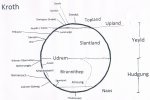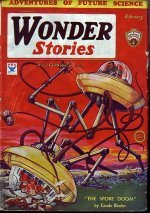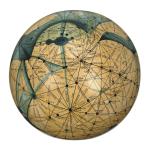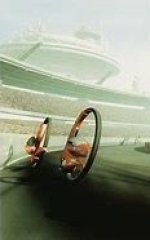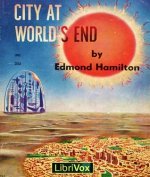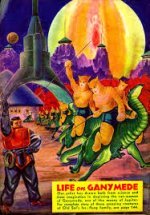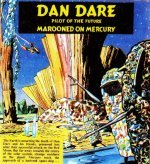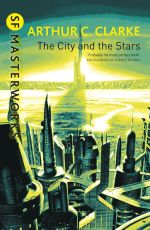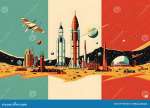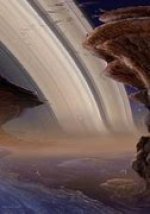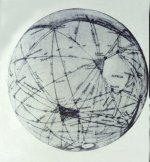the sunport vista:
zendexor's
oss
diary
2021
The would-be Samuel Pepys of the OSS...
2021 December 8th:
SNEAKING DOWN TO JUPITER
It can be quite intriguing to catch a writer out in an unguarded moment...
Arthur C Clarke's imaginations are, almost always, at the realistic end of the Old Solar System and indeed the only reason his work appears in this site is that much of it was written before the Space Age, thus dating from when the OSS and the RSS overlapped.
For example his great novel Earthlight (1955) portrays native plant life on the Moon - and does so quite convincingly, enough to make me wonder, even now, whether there might be a possibility of it being true. In all other ways the environment and the engineering challenges it poses are just as they might be nowadays, though the personnel side is different, being that of a dignified sprig of the old space program, instead of what we'll actually get if and when we found a real moon-base.
In that same novel, as you might expect of somebody writing before the Mariner 2 probe, he also mentions that Venus is being colonised. (He doesn't say what it's like, but makes it plain that terraforming is required before it's properly habitable.) Mercury is also mentioned, as is Mars (where terraforming had succeeded to the extent of giving the place a breathable atmosphere), the asteroids, and the satellites of Jupiter and Saturn. All these rocky worlds are united to form the Federation, politically distinct from the Earth-Moon system, and drifting towards war against it over the allocation of resources. So far, the extent of human colonisation in the mid-twenty-second century seems quite plausibly sketched out.
But there's one amazingly exceptional part of just one sentence in the book which seems to me to open up further vistas.
I'll quote the paragraph, and put the key clause in bold. The context is a radio message from a news-reporter on Venus, who is transmitting his views on the political resource-crisis. He is suggesting that dire consequences might ensue if Earth discovers new deposits of heavy metals and refuses to share them with the Federation:
"If this happens, and Earth tries to keep its discovery to itself, the consequences may be serious. It's all very well to say that Earth would be within its rights. Legal arguments don't carry much weight when you're fighting thousand-atmosphere pressures on Jupiter, or trying to thaw out the frozen moons of Saturn. Don't forget, as you enjoy your mild spring days and peaceful summer evenings, how lucky you are to live in the temperate region of the Solar System, where the air never freezes and the rocks never melt..."
And it goes on, realistic, realistic... everything realistic except for that astonishing bit about personally fighting the atmosphere on Jupiter. Slip of the pen, maybe? Did Clarke's subconscious take over for a moment in which his romantic side knocked scientific realism for six?
For there's no doubt, if you're fighting Jupiter's atmosphere, you're doing it on Jupiter. You have bodily descended into the tempestuous realm of the giant planet. Maybe you're floating rather than standing, but still, you're down there. I don't think that merely operating probes or biological constructs by remote control, as in James Blish's Bridge or Poul Anderson's Call Me Joe, really counts, even though the protagonists in those stories are hugely affected emotionally by what they are doing. So - if Clarke meant anything, he meant that some of the people of his Federation actually, no kidding, went down onto Jupiter itself.
It was just a blip. He couldn't really have meant it. Not he.
And so, in this one fascinating snippet, we glimpse a separate continuum in the act of budding off from the regular Clarke universe...
2021 November 28th:
THE CLOSE FRONTIER
Whenever I refer to a story, I also like to say where it first appeared - which is almost always in an sf magazine; and up till now I believe I have succeeded in giving the name of the magazine and the date of the issue that bears the story. Robert Bloch's The Fear Planet has, however, defeated me. I can only say it's in my copy of the anthology Far Boundaries, edited by August Derleth (1951). Derleth does not say where he got it from, and my efforts at googling the info have come to nothing. So - apologies for the failure to reference the tale properly.
I wouldn't call it a top-notch tale, but it exemplifies a telling point about the boundaries of OSS literature. The "planet" of the story's title is actually an asteroid. An asteroid, moreover, which (apart from its small size) has the characteristics of a full-fledged planet: a breathable atmosphere and sufficient gravity to hold it, plus plenty of native plant life, whose malevolent nature drives the plot.
All this amounts to such a serious flouting of scientific laws, that I'd class "habitable asteroid" tales of this sort as nudging the boundary of what is permissible, even under the lax rules of OSS science fantasy. But then, you see, habitable asteroids HAVE to be permissible. Their role in the sub-genre is quite essential.
Of course, the Old Solar System has plenty of room for adventure even without the asteroids - but the major planets have their own characters and aren't completely blank slates. What do you do, then, if you want to invent a world from scratch? You could go interstellar, or maybe out to the Oort Cloud, or use or invent an obscure outer-planet moon. But there's a special advantage in inventing a main-belt asteroid. The fact that the Belt is not so very far, compared to the outer limits of the System, emphasizes how adventure can creep up on you unexpectedly, as it were almost in your back yard. Thus, in a way, the element of surprise is easier to evoke if you venture onto an asteroid, than if you mount a deliberate expedition to the far frontiers. Unexplored asteroids - and there must be many of them since the Belt is so full of these little bodies - are like areas of waste ground in a populous city, where you can suddenly find yourself trapped by the unexpected.
Asteroids are, or can be, the cosmic equivalent of Lovecraft's murky New England towns, in which the far-out lurks near.
(Note: I've just found out, I wrote on this theme, focusing on this same tale, in the Diary for 17th June 2017. Heck! I'd completely forgotten. Is this because my sf collection is so vast, or because my memory is decaying?)
2021 November 21st:
POLE-SHIFTING
Erle Stanley Gardner, of Perry Mason fame, also wrote some sf stories earlier in his career.
I've just read and enjoyed a light tale of his which I would class as what I call "geophysical romance": that's to say its plot depends on a discovery concerning, and/or a change in, some physical characteristic of the Earth. I would say that hollow-Earth scenarios such as Pellucidar come under this heading, as do map-changing disaster stories such as Keith Laumer's Catastrophe Planet and Earth-extensions such as my Kroth trilogy. And a particular rare type of geophysical plot focuses upon a sudden global toppling, a dramatic shift in Earth's axis.
Until I read Gardner's New Worlds (Argosy, 17 December 1932) tale I the only example of this sub-genre known to me was Allan W Eckert's mighty tome, The HAB Theory (1976). I discussed the latter in the Diary for 24th September 2016.
New Worlds (meaning, the new worlds of opportunity which open out for the survivors of disaster) predates The HAB Theory by over four decades, yet it takes up where the later tale leaves off. Whereas Eckert devotes his 700-plus pages to detailing the political struggle faced by those who wish to demonstrate what's imminent, warn the world and prepare for the cataclysm, Gardner simply begins with when the event hits.
The hero, a likeable outdoorsy Arizonan, is on the New York subway at the time. At first he's repelled by the cold unfriendliness of his fellow-passengers, but soon perks up as his wilderness survival skills come in handy...
Gardner, unlike Eckert, gives no reason for the pole-shift. But then, Eckert's reason is no good. His idea is that as the weight of ice precipitated at the poles increases, Earth's spin is bound to become increasingly "top-heavy" and unstable, and eventually must topple and find a new axis at right angles to the previous one. Fair enough, if Earth were a perfect sphere; however, it is oblate, with an equatorial axis 27 miles longer than the polar, and a bulge of that size isn't ever going to be outweighed by any amount of polar precipitation.
So maybe Gardner did better in simply telling us that it happened...
Anyhow, I would recommend New Worlds as a pleasant read, and as material for an anthology of "Sf by non-sf authors". I wonder what its title could be. "Waywardness"? "Slumming"?
2021 November 17th:
ONE STEP UP FROM BRADBURY'S
MARTIAN RESISTANCE
The hapless natives of the Red Planet are more or less wiped out in The Martian Chronicles, and the remains of their culture vandalised. Admittedly their influence persists, exerting some kinds of haunting pull upon the Terran colonists, but this only shows that there can be a kind of post-mortem life for a defeated civilization.
A taste of the Bradbury scenario is carried over and given a more aggressive twist in Dawningsburgh by Wallace West (Galaxy, June 1962). As in The Martian Chronicles, WW's tale shows vulgarity lording it over an ancient and beautiful culture, but this time the plot is specifically focused upon the tourist trade. In a glitzy theme park, animatronic robots are used to mimic ancient Martians. One romantically inclined tourist, Betsy O'Reilly, is dissatisfied with the whole scene, goes out wandering at night, and touches what she thinks is one of the robots - only to find it inexplicably warm.
"Now," fluted the creature, turning and fixing her with golden, freewheeling eyes, "what brings a tourist" (the word was a curse) "here at this hour?"
"L-love," she gulped, hardly knowing what she said. "I - I mean, I wanted to find out if anything real was left. And, well, I ran away from the hotel. They'll be coming after me, I suppose."
"Don't fret. Martians can play tricks with time. I'll return you to your room well before they get here."
The Being is a smooth talker, glib with colloquial English, and friendly enough to Betsy, but -
"...But..." he shrugged angrily, "I grow tired of weeping. On this visit I plan to wipe out you little humans who foul the nest of my ancestors."
"How?" She gripped his arm, fear racing through her.
"Tomorrow all this junk - " he nodded his handsome head at the robots - "will have been replaced by real Martians... youngsters out for a lark with me. We'll tend shop, make jewellery and all that until I give the signal. Perhaps this shrine would be the best place. When it's crowded, just at sunset. Then we pounce!"
The story has an unexpected ending, which I won't give away. An instance, perhaps, of Martians and Terrans affecting each other - a kind of cross-fertilization of ruthlessness.
On a personal note, I can class it as one of those tales which seemed not as good when I read it in my twenties, as it seems now when I read it in my sixties; perhaps due to the positive baggage of literary context that enables me to see much more than the words on the page; a crowd of other imaginations looking over the shoulder of Wallace West's... all the various birdlike Martians, for instance, shimmering and merging...
2021 November 9th:
SATURNIAN TEDDY-BEARS
I still encounter surprises while browsing in old anthologies on my bookshelves; evidently there are quite a few tales in them that I have not read.
This truth was forcefully brought home to me yesterday while I was perusing The Third Galaxy Reader (ed. H L Gold, 1958). Some of the fiction is quite seriously good, and the light comedy is pleasant.
In connection with the latter I thought I'd better let you all know that The Vilbar Party by Evelyn E Smith (Galaxy, January 1955) features an academic and cultural exchange between Terrans and Saturnians, and that the Saturnian protagonist, a Professor Narli, is shaped like a teddy-bear.
Consequently he can do no wrong on Earth, where everyone thinks he's infinitely cute, so that he gets the most lavish treatment, his lectures thronged while he himself is socially lionised, and loaded with gifts and suitable foods, though as a reclusive creature he would much rather have been left in peace.
However, back on Saturn the authorities cannot believe he could have been treated so well. This, for me, is where it gets funniest.
Narli insists to his colleague, Slood:
"...I aroused pleasant childhood memories in them, so that they showered me with affection and edibles."
Slood closed his eyes in anguish. "You are very brave, Narli," he said almost reverently. "Very brave and wise and good. Certainly that would be the best thing to tell our people. After all, the Terrestrials are our allies; we don't want to stir up public resentment against them. But you can be honest with me, Narli. Did they refuse to serve you in restaurants? Were you segregated in public vehicles? Did they shrink from you when you came close?"
Narli beat the desk with all four hands. "I was hardly ever given the chance to be alone! They crawled all over me! Restaurants begged for my trade! I had to hire private vehicles because in public ones I was mobbed by admirers!"
"Such a short time," Slood murmured, "and already suspicious of even me, your oldest friend. But don't talk about it if you don't want to, Narli..."
Hence, in different ways, the roving academic from the Ringed Planet is misunderstood both by the Terrestrials and by his own people.
2021 October 4th:
UNLUCKY CEREAN GIANTS
Like the historian of Archaic Greece, who has to make do with pieces of broken pottery plus a few poets, the investigator of OSS Ceres must learn to squeeze what evidence he can find out of the scraps that fall his way.
Having recently worked on the page for that asteroid, with the help of a bonanza from Russell's Saga of Pelican West, I have had the place very much on my mind; whereupon, lo and behold, while reading Garrett P Serviss' creaker, Edison's Conquest of Mars, I find some unexpected references to a Cerean civilization. The Martians, so we're told by one of their human prisoners, have
"...waged war with the inhabitants of the asteroid Ceres, whose people are giants greater than themselves. Their enemies from Ceres have attacked them here. Hence these fortifications, with weapons pointing skyward, and the great air fleets which you have encountered."
Later, we meet one of these giants, who is trying to survive the disaster which the space-fleet from Earth has unleashed on Mars:
Standing on the apex of a sandy elevation, which still rose a few feet above the gathering flood, was the figure of a woman, as perfect in form and in classic beauty of feature as the Venus of Milo—a magnified human being not less than forty feet in height!
But for her swaying and the wild motions of her arms, we should have mistaken her for a marble statue.
Aina, who happened to be looking, instantly exclaimed:
"It is the woman from Ceres. She was taken prisoner by the Martians during their last invasion of that world, and since then has been a slave in the palace of the Emperor."
By this point in the story it's obvious that the book has evolved from being an inferior sub-Wells to being an inferior sub-Burroughs...
Be that as it may, though, it's Ceres that I'm concerned with here. The smaller the world, the lesser the gravity, the taller the inhabitants! Somewhat restricting! I mean, from their point of view, it must make their world smaller still. Let's do some calculations:
Taking the diameter of Ceres as 584 miles... that means 584x5280 = 3,083,520 feet. So its circumference is 3,083,520 x pi feet = 9,687,164 feet. Divide that by the height of the statuesque Cerean (40 feet) and you get the number of Cereans who, laid end to end, would stretch round the circumference of their world: a mere 242,179.
That gives some idea of how much elbow-room they must have.
Let's compare that with conditions on Earth. Take Earth's diameter as 7900 miles and the height of a Terran as 6 feet. 7900x5280xpi = 131,042,113. Dividing by 6, you get an elbow-room-quotient of 21,840,352. Wow, we've got it good compared to the poor old Cereans - granted, however, that you can't literally lay us end to end around the circumference of our globe...
2021 September 17th:
A NEW PODCAST SERIES
In recent weeks an international group of writers have teamed up to produce podcasts of literary discussion - the subject-matter being both new and classic literature. The series is called Roll Off a Tangent and the group includes a Russian, Nikita Zuev (who thought up the series' name), the Singaporean Xiangjun Zeng ("XJ", author of the Longtail series), the American space-opera writer Karen "Kaz" Augustin (contributor to Vintage Worlds volumes 2 and 3), and lastly the Briton, yours truly.
It's very much an open-ended thing, slanted towards sf and fantasy but not exclusively so. Nikita Zuev introduces it thus:
"Roll Off a Tangent is a group of writers from all over the world who discuss and critique fiction made by other authors as well as their own work. Join them if you are ready to plunge into the world of great leaps of fantasy and envelop yourself in their commentary."
Classics discussed so far include Robert E Howard's Conan tale The God in the Bowl, H P Lovecraft's The Call of Cthulhu, Clark Ashton Smith's Xeethra, M R James' horror-tale Lost Hearts, and the non-sf Sherlock Holmes adventure The Red-Headed League.
It's a series which aims also to include discussions of our own as yet unpublished works, and because Roll Off a Tangent has as yet no website of its own, I have agreed to host these stories here on Solar System Heritage, at least for the time being.
You probably will see some tales which do not at first sight seem relevant to the Old Solar System. Yet indirect connections can be argued to exist, since planet Earth belongs to almost any fictional universe. Besides, I like my site to expand penumbrally to welcome guests whom I know to be imbued with the right spirit even if they do stray beyond the Oort Cloud.... So far, Nikita Zuev's interstellar catastrophe story Delegators (podcast yet to be released) is the only one that thus breaks the OSS bounds.
Closer to home, we have also discussed chapter 1 of Xiangjun Zeng's Longtail epic set in a far-future Solar System, and my Plutonian invasion story The Slavanns Must Play. Kaz Augustin has also assured us that she will have a story for us to debate over before too long.
Next podcast will be devoted to Weinbaum's A Martian Odyssey... a topic suggested by Kaz, and one which must gladden any areophilic heart!
2021 September 11th:
THE TIPPING-POINT FOR WORLD-BUILDING
Re-reading some of Clark Ashton Smith's wonderful "Averoigne" stories set in an imaginary magic-haunted French province, I found myself for the umpteenth time wondering about the anomalous date of 1798 for the tale called The End of the Story.
I had always assumed that it was a misprint, perhaps confined to the 1960s paperback edition of Lost Worlds. After all, how could a wanderer come across a functioning abbey in 1798, under the anti-Christian revolutionary First Republic? Besides, the tale has a thoroughly medieval, or at least early-modern, feel to it.
But only on this occasion did it occur to me that I could check by looking up the story on the Smith website, The Eldritch Dark.
I did so, and found that the site agrees with the book: the date 1798 for the narrative is on the page for that tale.
But then, I thought, maybe some other readers have noticed the anomaly and discussed the matter. After a search I found that they had!
http://www.eldritchdark.com/forum/read.php?1,12290
(Sorry if this link doesn't work. You can instead try googling "1798 mistake in clark ashton smith the end of the story", like I did, and that should get you there.)
You'll see, if you reach that forum, that quite a few CAS fans are spending time and thought over the question, and chatting about how the adventure with the abbey and the nearby dreaded chateau of Fausseflammes might have taken place in 1798 after all.
So whereas for instance one reader objects: In 1798, there were no abbeys – not anywhere in France. In 1789, the French Third Estate had declared itself the “Assemblée nationale constituante” and that November, it declared all Church holdings “Biens nationaux”. That is: state assets, which would back up public bonds (Assignats)...
...another one counter-argues, ...Hilaire takes pride in his abbey’s vast collection of profane literature
and is clear to disassociate his lenient order from others (like
Cistercians). These are well within the concerns of a liberal cleric of
the 1770s and 1780s.
Propose that Smith’s date in 1798 reflects the paper’s rediscovery and filing, and not the date of writing, more likely 1778.
A praiseworthy effort at excuse-making, this! And there's a lot more, speculation going to and fro, all of it an implied compliment to a writer who can inspire such loving attention to the task of justifying his apparent inconsistencies.
This is what I'm leading up to: the theme to which I have previously alluded in other contexts - that of the achievement of some writers, whose inventions attain a stage at which their allure enlists the reader on the side of excuse-making wherever excuses are needed.
World-builders note: you don't have to worry too much about ironing out every inconsistency. All you have to do is get to be as good as Clark Ashton Smith or Edgar Rice Burroughs, and your fans will take on the work for you.
2021 August 22nd:
BLUE SNOWFIELDS ON NEPTUNE
Here's another of the illustrations in the 1969 booklet "First Interest in Space: The Planets". I can imagine how it might have fascinated me if I had seen the picture as a little child. But it's a bit surprising that the surface of a gas-giant planet should have been thus portrayed at that date. So - switch on the excuses:
Maybe it's Neptune far in the future when the atmosphere has somehow naturally thinned or even disappeared... Or maybe the reality-engineers have been at work on it.

2021 August 21st:
NAIVE JOVIAN VIEW
Yesterday's entry in this Diary turned out to be largely a repetition of a similar entry 45 months ago, 20th November 2017 - my apologies for repeating my comments. This site has become so huge, I'm losing track of what's in it. Never mind: abundance is preferable to dearth...
Anyway, today's entry, regarding a picture from the same children's "science" booklet, is, I'm fairly sure, new to Solar System Heritage. The outrageously unrealistic Jovian landscape, with not only a solid surface but also a transparent atmosphere and six fat moons all squashed together in one portion of sky, takes some beating!
Rather than denounce it, as good old Asimov would doubtless have done, I switch my excuse-making powers into top gear, and envision something like:
"The Jovians must have special vision depending not on mere photons but on some more direct perception of reality, allowing them to see the stars from ground level, and group them together by variable adjustment of magnification in order to nullify the discrepancies of distance..."

2021 August 20th:
EXAGGERATING MERCURY'S SUN
Among my teaching materials I recently re-discovered an old booklet, dated 1969, in a series designed to help young children learn to read and to learn about science. The title is "First Interest in Space: The Planets" - the author being one Jeffrey Edelman.
Many of the illustrations are very dodgy from the scientific point of view! A mild example of this is its Mercurian landscape. Not surprisingly, I like it. The over-the-top enormous Sun (as though the planet were about 5 million instead of about 36 million miles from it) is a good instance of the way measurement serves qualitative needs in the OSS, rather than furthering the requirements of accuracy.
It's a picture of an emotion; a rendering of one's feelings for the place.

2021 July 28th:
THE ZELAZNY VENUS
By rights I ought to have composed a page on Roger Zelazny's 1966 Nebula-Award-winning Venus tale, The Doors of his Face, the Lamps of his Mouth.
After all, I have managed to provide a page on his renowned Mars tale, A Rose for Ecclesiastes.

For reasons which I find hard to pin down, though, I so much prefer the Mars story to the Venus one, that I have so far paid hardly any attention to it on this site, despite the fact that I applaud the author's decision to ignore the dismal results from the Mariner 2 probe and, instead, depict Venus in its traditionally habitable guise.
Yesterday however I was pleased to get an email from Dylan Jeninga which to some extent makes up for my neglect of Doors. Here are his comments:
I'm writing because I finally found, and read, a copy of Zelazny's Venus story! A few things occur to me at once.
The first is that I wrote a story about Old Solar System space-whaling as well [see The Sea Empress], although Zelazny and I had different aims (and of course Zelazny is a more adroit writer than I; he deftly handles two related but separate conflicts, one internal and one external).

The second is that Zelazny has written as pure an OSS Venus as can be found anywhere. I know the story is mostly famous for having been published after Venus was exposed as a toxic husk, but I think OSStronauts should read it for a chance to feel at home on Venus they know and love. The continent called "The Hand", the tropical seas, the inky nights, the great beasts - yes, this is quintessential Old Venus.
The
third is that Zelazny has given his baitman an excellent voice. More
than once I found myself smiling at a clever turn of phrase. I didn't
actually like the guy very much, but he was a well written protagonist.
I do have a couple criticisms. Like many stories of the day, it features a romance that struck me as shoehorned-in, and I think the story would have been a bit stronger if it just focused on the baitman's fear. Also, Zelazny's habit of long dialogues with no identifying tags means that I sometimes lost track of who was talking.
I
know you didn't care too much for Doors, and preferred A Rose for
Ecclesiastes. I'm surprised to say I actually feel the opposite. For me,
it really comes down to getting the planetary personality right:
Zelazny's Venus feels like Venus, but his Mars... to me, it just didn't
feel Martian. [This is a very interesting disagreement; I hope that someday it may be further explored. The quiddity of literary Mars is a great target for analysis. An example of a Mars that doesn't feel Martian to me is that of Michael Moorcock's City of the Beast and its sequels.]
PS: I have no idea why the story is called "The Doors of his Face, the Lamps of his Mouth". [Nor do I - though I'd say it has a Whitmanesque ring to it.]
It only remains for me to add, that I've begun to wonder if maybe I should re-read that Venus tale after all...
2021 April 11th:
LIVING WORLDS
The idea that worlds might be giant planet-sized creatures, actually alive, and that we are mere mites living on the skin of one of them, is on the borderline of what can be fitted into the sub-genre of the Old Solar System.
Re-reading Arthur Conan Doyle's "Professor Challenger" stories recently, the short story When the World Screamed (1928) got me thinking: it's the only example of its kind I can think of in the literature, apart from Jack Williamson's Born of the Sun (Astounding, March 1934).
To my way of thinking, the Williamson tale is too over-the-top to fit the genre. It's an end-of-the-world tale, for if the world is an egg and it hatches, that's the end of it all as far as we're concerned.
The Doyle tale on the other hand is based on a premise which the OSS and its protagonists can live with. Instead of being an egg about to hatch, the Earth (and its neighbouring planets) are spherical adult creatures, globular like sea-urchins, and just as the sea-urchins imbibe floating nutrients, the planets draw sustenance from the apparent void, as Challenger explains:
"...The earth browses upon a circular path in the fields of space, and as it moves the ether is continually pouring through it and providing its vitality. Quite a flock of other little world-echini are doing the same thing, Venus, Mars, and the rest, each with its own field for grazing..."
These planetary creatures carry on existing peacefully unless they are disturbed; but Prof. Challenger unfortunately aims to disturb. He investigates via a deep mine... hence the title of the tale. The resultant havoc is considerable but civilization survives it.
Less physical "living-world" scenarios can be found in the writings of Olaf Stapledon, where the planetary intelligence is the emergent group mind of its inhabitants, and in my Uranian Throne, in which the "World Spirit" of the seventh planet is some kind of tutelary sentience, which I'm defining gradually as I go along.
One of Stapledon's Last Men describes the planetary group-mind experience:
...The individual discovers himself to be embodied in all the bodies of the race. He savours in a single intuition all bodily contacts, including the mutual embraces of all lovers. Through the myriad feet of all men and women he enfolds his world in a single grasp. He sees with all eyes, and comprehends in a single vision all visual fields. Thus he perceives at once and as a continuous, variegated sphere, the whole surface of the planet...
Stapledon has his advanced human intelligences unwittingly affecting natural forces via the effect of their mind-power, and this distorts the pull of gravity, an alteration which, for the last Terrestrials, has a disastrous long-term effect on the Moon's orbit, and hastens the end of the world. My non-human "World Spirit" is entirely harmless by comparison - its laudable aim is to prevent humans from taking too much control over the environment and thus wrecking the place.
To those of us who like ongoing series of tales, it's important to avoid any final catastrophe!
2021 April 9th:
GAZING ACROSS THE CASSINI DIVISION
What would it be like actually to stand on a ring-particle on the edge of Saturn's A Ring and look across the gap to the B Ring, or vice versa?
Here's a passage from a fairly run-of-the-mill sf adventure published in 1954, Donald Wollheim's The Secret of Saturn's Rings:
...before him, seeming but a step away, was another ring, a flat circular platform to his eye, darker than his ring, but still glowing silent and untenanted in the sky. Between him and that other platform seemed but a short distance, a narrow gap over starry depths.
Bruce knew that this was a dangerous illusion. This was no narrow step, no close-lipped abyss. This was a space that was not a few hundred feet or even a few miles wide. It was a gap two thousand two hundred miles across! It was like the distance from New York to Denver...
Why am I writing about this in a website dedicated to the Old rather than to the New Solar System? Well...
Elsewhere in the novel we find the OSS idea that [spoiler alert] the Rings are the remains of an inhabited Saturnian moon, of which the extinct inhabitants left traces of colonies on Mimas before accidentally blowing up their own world. Yet the view across the Cassini Division described above would in itself fit logically into a more realistic, NSS novel.
But - here's a thought:
The OSS could also be a matter of the spirit with which the reader is invited to approach the plot. Perhaps a naively wondering gaze across the 2200-mile gap in the Rings could, in that spirit, count as fitting in with the corpus of old literature.
Here's another, similar instance where the attitude is what counts:
One particular world straddles the boundary between Old and New Solar System. That world is our Moon, which may, within a few years, be re-visited by man.
Not only in NSS but in much of OSS fiction the Moon is portrayed as uninhabited by any native form of life. Yet that lack of an organic side doesn't debar it from being a place of enchantment and wonder.
Perhaps, then, in some areas, we as explorers (armchair or literal) can bring the OSS spirit with us wherever we go...
2021 April 2nd:
ATOLLS IN THE LUNAR SEAS
Oliver Morton's Mapping Mars (2002) is a good read for the history of planetology and, hence, for the history of our beliefs about other worlds, especially Mars and the Moon. And if we can't have neighbouring worlds which are habitable or even which were once habitable, the next best thing is to empathize with those who used to believe we could.
On page 78 of his book Morton (focusing on nineteenth-century speculation) writes:
...To make their case for the volcanic origin of the moon's craters, Nasmyth and Carpenter created a scale model of what Vesuvius and the bay of Naples must look like from above and compared it with similar models of the lunar surface. Other lunar analogies on offer suggested that the dark expanses of the moon called 'seas' were in fact made of ice, or that they were the dried beds of seas now vanished. Charles Babbage, the pioneer of mechanical computing, elaborated on this idea with the notion that craters in these dried seas were in fact coral atolls like those studied by Darwin...
Just think what it would feel like, actually to be able to believe that last idea.
If reality-engineering were possible, the next step would be, some creative mind-over-matter process, reminiscent of the Krell's "Night of the Monsters" in the movie Forbidden Planet. Hmm...
If ever this website should disappear, it may be because some Time Patrol censor has judged it to be too dangerous.
2021 March 23rd:
DE-LUXE SCIENCE-PATTER
Many
times have I tried to make the point that the function of science in
golden-age OSS sf is as an incantation rather than as a serious
speculation. The incantation is important, but it need only be
perfunctory in order to suffice. A good example is the excuse given in Skeleton Men of Jupiter
for the way John Carter can jump lightly around on the giant planet.
The simple answer quickly satisfies him: that the centrifugal force of
Jupiter's rapid rotation counteracts the enormous gravity. No reader
believes this could really be true, but the right incantation has been
made.
Sometimes, though, it can be more than perfunctory.
Consider the very interesting speculation on the formation of lunar craters in Heinlein's Blowups Happen (Astounding Science Fiction, September 1940). The speaker edges gradually towards a momentous conclusion which I aim to discuss at another time; here's his start:
'Although we are in the habit of referring to the "craters" of the moon, we know they are not volcanic craters. Superficially, they follow none of the rules of terrestrial volcanoes in appearance or distribution, but when Rutter came out in 1952 with his monograph on the dynamics of vulcanology, he proved rather conclusively that the lunar craters could not be caused by anything that we know as volcanic action.
'That left the bombardment theory as the simplest hypothesis. It looks good, on the face of it, and a few minutes spent throwing pebbles in to a patch of mud will convince anyone that the lunar craters could have been formed by falling meteors.
'But there are difficulties. If the moon was struck so repeatedly, why not the earth? It hardly seems necessary to mention that the earth's atmosphere would be no protection against masses big enough to form craters like Endymion, or Plato. And if they fell after the moon was a dead world while the earth was still young enough to change its face and erase the marks of bombardment, why did the meteors avoid so nearly completely the great dry basins we call the seas?
[Here's the first chink in the edifice of plausibility, for we now know that the lunar maria originated in an outflow of lava subsequent to the great bombardment; in other words, the lava covered the impacts there. Still, the wonder of the tale is greatly enhanced by this mood of hard investigation.]
'I want to cut this short; you'll find the data and the mathematical investigations from the data here in my notes. There is one other major objection to the meteor-bombardment theory: the great rays that spread from Tycho across almost the entire surface of the moon. It makes the moon look like a crystal ball that has been struck with a hammer, and impact from outside seems evident, but there are difficulties. The striking mass, our hypothetical meteor, must have been smaller than the present crater of Tycho, but it must have the mass and speed to crack an entire planet.
'Work it out for yourself - you must either postulate a chunk out of the core of a dwarf star, or speeds such as we have never observed within the system. It's conceivable, but a far-fetched explanation.'
[As I understand it, this is another discrepancy between the problem as set out in the story and what we now know: the Tycho rays are not cracks, they are ejecta; that's to say, splashes from an impact. But by this time the reader is ensorcelled... and ready for the soul-shaking conclusion...]
He turned to King. 'Doctor, does anything occur to you that might account for a phenomenon like Tycho?'
The
Superintendent grasped the arms of his chair, then glanced at his
palms. He fumbled for a handkerchief, and wiped them. 'Go ahead,' he
said, almost inaudibly.
[The next part will be dealt with anon, when I find the time. I reckon it will need a page devoted to it.]
[Note, 4th May: now done - see The Implicizer Aimed at "Blowups Happen".]
2021 March 16th:
IONIAN GRADATIONS
On the Io page I trace the theme of decline, cultural and environmental, on that tide-racked innermost Galilean satellite. I cite visions ranging from the degenerate descendants of a lost civilization in Weinbaum's The Mad Moon, to the poignant but dangerous relic of an utterly extinct culture in Gallun's The Lotus Engine (in which "vision" is exactly the right word!).
And now as I read Harl Vincent's The Copper-Clad World (which first appeared in Astounding Stories, September 1931, or so says the paperback edition), I wish to find a place for it within the above fictional range.
As the title implies, the Ionians have given the entire place a metal roof. It's their way of conserving the atmosphere and hence the life of their world.
...They were outside then, on the palace roof, and Pegrani motioned them to a railed-in runway that circled its edge. High overhead was the shadowy blackness of the copper shell that enclosed the satellite. Huge latticed columns, line upon line of them, stretched off into the distance as far as the eye could follow; enormous white metal supports that carried the immense weight of the covering which retained the dense and humid atmosphere. Myriads of tiny blue-white suns there seemed to be, stretching off between the columns, carried on thick cables and radiating the artificial daylight of the interior. Hot, damp odors wafted across the roof, the odors of decayed vegetation.
Most amazing of all, were the dwellings. In orderly rows like the columns, they were flat topped cylindrical things that reminded Blaine of nuthing so much as the tanks of an oil refinery back home. And the space between was overgrown with dense tropical vegetation, tangled and matted and shooting transparent tubular stems up to a height of a hundred feet or more where they sprouted great spherical growths that looked like enormous sponges. Of a sickly, pale green hue, these growths overran everything; climbed the columns and were lost in the shadows above the multitude of lights. The big sponge-like blossoms expanded and contracted rhythmically. Breathing, they were like living things. Specially cultivated plant life to assist in maintaining the oxygen supply balance by decomposition of carbon dioxide. A marvelous artificial world!
(I'm not sure from the descriptions as to how high the roof is... For another excerpt from this tale, see What to see on Io.)
The roofed-world theme reminds me of a somewhat similar arrangement for Earth, in Brian Stableford's Realms of Tartarus series - though in the latter, the aim is not to preserve the planet's atmosphere (which isn't under threat) but to create a new, clean upper tier of unpolluted land. Stableford imagines the old surface abandoned to a nightmarish darkness, where forgotten men and other creatures still lurk...
2021 March 10th:
THE ORIGINAL "SPACE SARGASSO"
I'm guessing - having just re-read Edmond Hamilton's The Sargasso of Space (Astounding Stories, September 1931) - that that tale was the first of its kind.
I could be wrong - in which case please correct me, anyone who knows.
What's more interesting in my view is that it helps us to trace the development of an idea in that author's work, together with an improvement in his writing skill.
I'd call the 1931 story a fairly good effort for the pulps of that time:
"The dead area," Crain told them, "is a region of space ninety thousand miles across within Neptune's orbit, in which the ordinary gravitational attractions of the solar system are dead. This is because in that region the pulls of the sun and the outer planets exactly balance each other. Because of that, anything in the dead area will stay in there till time ends, unless it has power of its own. Many wrecked space-ships have drifted into it at one time or another, none ever emerging; and it's believed that there is a great mass of wrecks somewhere in the area, drawn and held together by mutual attraction."
Note that this fobs us off with an inanely implausible excuse for the existence of the "dead area". With planets and moons orbiting and changing their mutual positions constantly, there'd be no chance of a gravitational stasis-zone in the terms given above, and any reader of the pulps in 1931 would have realized this after giving it a moment's thought. Of course, you don't need plausibility in OSS pulp fiction, you just need to make a respectful nod in the direction of science, and that passage provides it. However, it's possible to do the job more imaginatively, and nine years later, in Calling Captain Future (1940), Hamilton does so:
"...there are many strong ether-currents, strange running tides in the luminiferous ether itself, out in this part of the System. They all flow into a central vortex, and anything that is carried into the vortex can't get out again, against the currents. That central vortex is the Sargasso Sea of Space."
Ether-currents! Central vortex! That's more like it! Further from known science than the 1931 excuse, it is paradoxically more conducive to that suspension of disbelief which permits pseudo-science its literary effect.
"Running tides in the luminiferous ether" help give Captain Future's science its zing...
2021 January 18th:
MEDITATION ON THE PAGE-VIEW WINNERS
Accentuating the positive, here are some heartening developments which distinguish the latest table of page-view winners from those of the previous year, and which may interest readers who are wondering where to browse next in this multi-hundred-page site.
Titles which have risen from relative obscurity to join the ranks of the "super-pages" (= viewed on average one or more times a day) include favourite authors of mine such as Keith Laumer, Raymond Z Gallun, James Blish and Charles L Harness. The same surge has happened to pages devoted to one particular book - see Red Planet and Earthlight. Still more dramatic has been the rise from less than 1 to more than 2 views a day: see Sailing the Seven Spaceways, My Favorite Anthology, Uranian Eras and World of Never-Men.
Now for the jumps spotted further up the scale:
Those promoted from "super" to "para" (2 or more views a day) include: Arabella of Mars, Characters of Worlds, The First Men in the Moon, James A Corey, Robert Gibson, Planet X, Silicon Life, S M Stirling, The Sky People, Edmond Hamilton, An Approach to World-Building, Time Travel and Reality Change, Far Future, The Many Solar Systems Interpretation, Valeddom, Moral Dimensions, COMOLD and In the Courts of the Crimson Kings.
Leaping from "para" to "meta" (from 2+ to 3+ views a day): The Asteroid Progenitor Planet, Saturn, Mercury, Pellucidar, About Us, Leigh Brackett and Names.
And from "meta" to "hyper" (3+ to 4+): Interplanetary Knock-Out and Perelandra.
Finally, there were a few surgers who leapt up more than one rung. These especially sprightly pages are: Zones Cup (2+ to 4+), Barsoom (1+ to 3+), A Rose for Ecclesiastes (1+ to 3+), Kroth (1+ to 3+), and most athletic of all, Uranian Gleams (1+ to 4+).
(I've not mentioned the losers, those who went down the table or fell off it into the ranks of the non-super. But in truth the risers outnumbered the fallers: 14 went off the list but 68 went on. I will just specify one odd come-down, that of poor old Titan, which descended from 2+ to 1+ - and from 27th to 152rd place on the table. Let's hope the Titanics enjoy a renaissance in 2021...)
2021 January 16th:
STATE-OF-THE-SITE MESSAGE
Looking back over the Diaries of previous years it is easy to note that the entries have been getting fewer.
Why should this be so? Three answers whisper in my mind:
1. "You've covered most of the important ground; you're running out of the real classic material. Don't expect to find any more masterpieces to write about. You're scraping the bottom of the barrel now."
2. "You've been too busy teaching and writing - especially writing. It takes effort to keep up the old-style intensive Diary. Besides, you're not getting any younger."
3. "It's natural that, having covered past literature, your effort should be directed at the future - at NOSS tales, both those written by you and those written by others. That's what should occupy your thoughts now."
These three points do have some validity but I'm not comfortable with them.
With regard to the first point, all right, maybe the top masterpieces have been covered, but the second-rate stuff is still good (much better than the fifth-rate) and I certainly haven't got all of that yet. Bear in mind that I only have two collections of the stories of Jack Williamson. Most of his stuff I haven't seen. And I wouldn't be a bit surprised if there are some cracking Edmond Hamilton tales I haven't heard of yet. The existence of Treasure on Thunder Moon, set on Oberon, came as a complete surprise. And this very morning, Dylan Jeninga alerted me to an author I'd not known about, one David Wright O'Brien (1918-1944), killed in action in World War Two, who by the end of his short life had over fifty published pulp-magazine tales to his credit.
The second point, about being too busy and getting old, yes, that's valid. I don't even understand how I found the time and the energy to write all the pages which I have written. I must have been a lot more dynamic even five years ago. Still, I remain reasonably crepit...
The third point, about looking to the future - yes, it's fair enough. The anthology series Vintage Worlds looks set to continue to infinity, and who knows how many budding NOSS novelists may blossom in the years to come?
With that heartening thought, I wish all you Diary-readers a belated Happy New Year.

